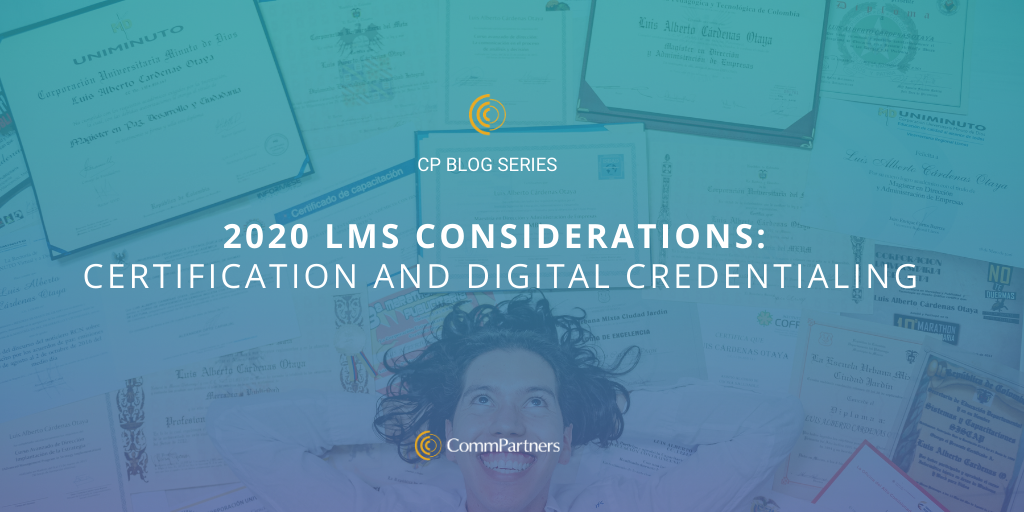
by Julie Ratcliffe | Oct 28, 2020 | Blog
As more and more learners migrate online and associations expand their LMS offerings, it’s time to consider creating a robust professional development experience by rewarding learners for accomplishing courses or personalized learning paths. Digital badges and certifications are confirmations of accomplishments that learners can carry with them throughout their careers.
While we continue looking deeper into CommPartners’ CEO Rich Feinstein’s The Evolution of the Association LMS: 10 Considerations for 2020, we consider why certification opportunities and digital credentialing are worthy investments for your LMS. Sometimes these tools can be an additional investment to your LMS, but it’s really an investment in your learners. Not only do they measure achievements, badges and certificates are tangible assets with defined outcomes your members can use professionally.
When considering including a badging or certification program with your LMS, it’s important to understand how they work:
Integrating badges into your LMS A digital badge is a portable digital icon embedded with data that verifies a learner’s skills, credentials, and continuing education experiences. Badges function in 3 parts:
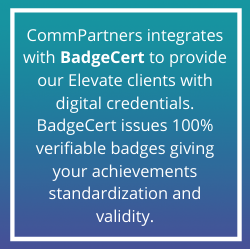
-
- Motivation: Badges act as motivation for learners to continue on their learning journey. When rewarded for completing courses, it encourages more participation. When learners can share their badges on their favorite social media channels or within the LMS, it motivates them to earn more to share more.
- Assessment: A badge is obtained when knowledge is obtained, thereby assessing skills and tracking progress. As they continue to build on their skills, they will gain more badges and target areas that require more attention.
- Credential: Badges act as credentials. Learners can share badges on their favorite social media channels to show their achievements and verify their particular expertise in a subject.
Issuing certifications from your LMS
Another way to measure success and provide value through your LMS is through certifications. Many association members are looking for professional development opportunities and providing your members with a virtual option to obtain and maintain their professional certifications is a must. Issuing certifications through your LMS creates an organized and simple solution for your members to continue growing and learning.
Simplify Certification
Issuing certifications is simple when your LMS and AMS integrate seamlessly. Your LMS will track progress, results, and credits automatically without you or learners having to stop and thinking about it. Your certification module will track pre-requisites, credits earned, hours spent, etc. and record it to a transcript.
 Obtain and Maintain Certification
Obtain and Maintain Certification
Many associations and professions require specific certifications or licenses’ to practice within a field. When members can obtain and maintain their certifications through your LMS, it becomes a one-stop-shop experience.
Measurement of Success
Similar to a digital badge, your organization has the option to provide your learners with a certificate confirming they’ve completed a course or learning pathway and achieved a level of expertise in a subject. A certificate can point out skill gaps and areas where extra attention is necessary. It can also prove attendance for certain professional events and conferences to receive credits from issuing organizations.
Investing in certification and digital badging means providing opportunities for your learners to grow their skillsets and encourages them to explore your LMS content. They will begin mastering content and broader levels of expertise, attracting an increased number of participants. This is incredibly important during this time of amplified virtual learning.
If you are interested in incorporating badging into your LMS or want to learn more about Elevate LMS, contact Meghan Gowen at mgowen@commpartners.com.
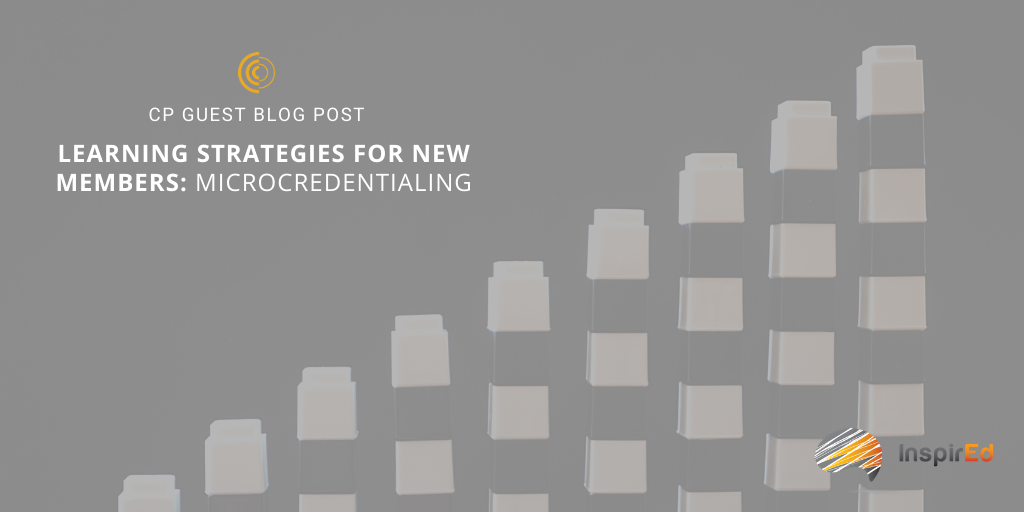
by Julie Ratcliffe | Oct 14, 2020 | Blog
This is a guest post written by Tracy King, CAE. As CEO of InspirEd, Tracy King leverages her more than 20 years in workforce development consulting with organizations on education strategy and learning design. Tracy is the author of Competitive Advantage: Create Continuing Education that is Profitable, Sustainable and Impactful, and she advises on how to grow reliably profitable and sustainable continuing education programs that transform learners. Tracy specializes in the intersection of learning science and technology. She’s a thought leader, invited speaker, master learning designer and DELP Scholar. Her work has been featured on NBC, ABC, FOX, USA Today, The Star Tribune and hundreds of nationally-syndicated television, newspaper, and magazine outlets. Tracy is a contributor to Microlearning in the Digital Age: The Design and Delivery of Learning in Snippets forthcoming by Routledge, Taylor & Francis group.
Learning inherently solves problems. It is designed to help us be or do something new, better, or differently. Learning programs that resolve top of mind challenges are a member prospect magnet. If you’ve been considering getting into the microcredentialing game, target the member segment you want to grow and build quick-win problem-solution learning that offers digital badge credibility (of course branded to your association).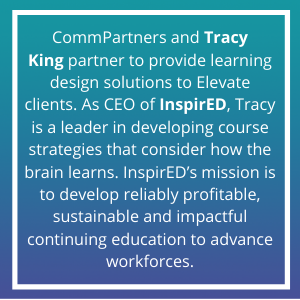
Ideally, this should be the next step call to action you offer after member onboarding. While any of your meaty digital programs could serve as that next step, microlearning is easy to commit to and can be accessed via mobile for those professionals who just can’t take another minute in front of their laptop screen. If you’re going to design microlearning curriculum that solves problems and inspires behavior change, your organization and your new member both benefit from taking the additional step to qualify it as a digital badge. Your new member gets to solve a problem and share their accomplishment. Your organization’s visibility as the problem solver naturally grows.
One more tip: Free microlearning should dovetail into paid programs conveniently located in your LMS to learn more and tackle deeper skill development. By winning trust with a quality initial learning engagement, an additional investment becomes an easier decision to make.
Wins
-
Quick-win learning is an easy commitment and has higher completion rates
-
Giving new members a micro byte generates an appetite for higher-investment learning programs
-
Getting new members started immediately increases the likelihood they will realize membership value – and sharing their digital badge tells your story in their network giving you greater market visibility
These ideas work in tandem so it’s important that you familiarize yourself with both parts of this series. Once you feel comfortable with both Part 1 and 2 of Learning Strategies for New Members, it’s time to implement these strategies:
Start with what you have and map out the digital pieces you need to complete your programs so you can divide and conquer. Consider:
- What assets do we have, what do we need, and what can be modified to create our new member onboarding journey?
- What critical pain points could we begin addressing through microcredentialing that would not only attract new prospects but become the perfect segue to our paid programs?
With these strategies, you will be prepared to meet new members with curated content that will guide them effortlessly through your learning catalog.
If you’re interested in transforming your learning design, contact Tracy at info@inspired-ed.com. If you’re interested in Elevate LMS or in onboarding strategies for Elevate LMS, contact Meghan Gowen at mgowen@commpartners.com.
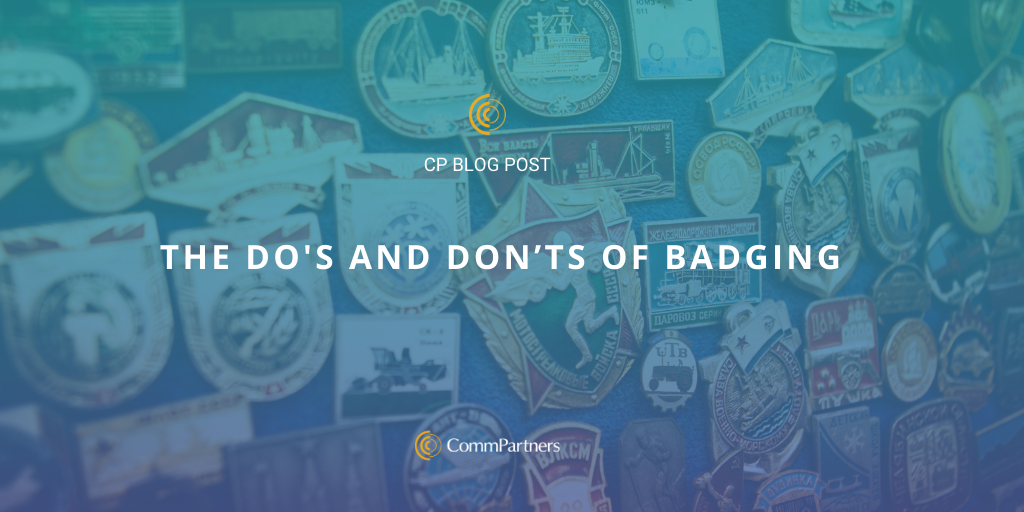
by Julie Ratcliffe | Oct 8, 2020 | Blog
When running a marathon or 5K, there is usually something that pulls you towards the finish line. Something that keeps you going to the next mile when you feel like giving up. Something that makes you want to do it all over again.
For some, it may be the health benefits; for others, it may be the thrill of the sport; maybe it’s the satisfaction of completing something. No matter what it is, you receive a symbol of your accomplishment when you finish the race. A medal. That symbol tells you that you worked hard, completed a task, and now you have a tangible token to share with your community of your success and skill.
Learners need the same thing. As they work their way through content, you may consider using digital badges as encouragement and rewards for a job well done. Incorporating badging into your LMS is a great way to motivate membership while validating their accomplishments.
Before you offer badges to your learners, check out our “do’s and don’ts” of badging:
- DO implement a badging strategy: Handing out random badges is not a good idea. Make sure there are criteria for each learner to meet to earn a badge. That criteria should include course structure, pre-requisites, who approves the badges, who is eligible, etc.

- DON’T forget to pair with a trusted badging expert: CommPartners integrates with BadgeCert to provide our Elevate clients with badging credentials. Badges are only as good as the organization providing them. BadgeCert issues 100% verifiable badges giving your achievements standardization and validity.
- DO use it a motivator: At the heart of badging is motivation. By rewarding your learners’ achievements, they will want to continue learning and achieving.
- DON’T make it too easy: Create skills-based (soft or hard) badges for learners in specific fields or job-tracks. Create badges to strive for!
- DO make badges shareable: Badges are evergreen, meaning they stay with a leaner from position to position. Posting badges on social media is an excellent way to share expertise with their network while receiving colleagues’ endorsements.
- DON’T over-badge: According to Ginger Malin, Founder and EVP of BadgeCert, “you want to be careful not to ‘over-badge.’ We suggest as a rule of thumb that badges should be assigned for either course completion or for modules that can stand on their own. This way, even if an individual does not want or need to initially share the badge, they would have a verifiable digital credential to share when desired.”
- DO encourage LMS exploration: Award learners with a badge for exploring your LMS site. They will benefit from gaining an intimate knowledge of the site when they begin their learning journey.
Whether badges are shared on networking sites or within the LMS, digital badging provides your learners with the motivation to continue their professional development path while expanding their expertise from LMS content. To learn more about Elevate LMS or how to incorporate digital badging into your LMS, contact mgowen@commpartners.com.

by Julie Ratcliffe | Sep 30, 2020 | Blog
Happy International Podcast Day!
Whether you listen in the car, while you work, or just as a way to pass the time during quarantine, podcasts are a source of education, entertainment, and information. Over 50% of the US population
has heard a podcast and there are over 1,000,000 podcasts out there to choose from. There are plenty of podcasts for association professionals that are great resources while planning your next virtual event, developing an eLearning strategy, or as a way to keep on top of things in your industry. If you’re looking for the next podcast to listen to during your workout, here are just a few we’re listening to on International Podcast Day:
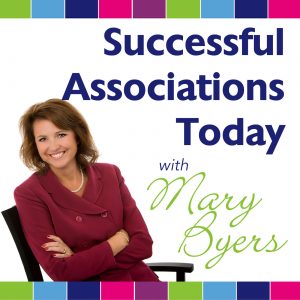
Successful Associations Today – Mary Byers
As an established figure in the association space, Mary touches on every topic an association professional faces daily, while her guests provide valuable and actionable insights. There is something for everyone in the show.
Association Chat Podcast – KiKi L’Italien
Kiki features episodes and guests that go beyond the association world. These topics provide fuel for thought that can create a stronger organization that serves everyone.
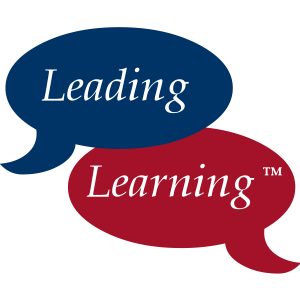 Leading Learning Podcast – Jeff Cobb and Celisa Steele
Leading Learning Podcast – Jeff Cobb and Celisa Steele
Leading Learning offers great perspectives on implementing eLearning strategies within your organization. Some episodes feature learning professionals and some you can find Jeff and Celisa discussing learning methods.
Meeting Minds – EideCom
This show talks about planning and hosting events. We recommend checking out 11 Virtual Event Mistakes. It has excellent tips for what to avoid while navigating the virtual event world!
 Gather Geeks – BizBash
Gather Geeks – BizBash
BizBash brings us another events-based podcast. This show centers around events, mostly in-person, but there’s been increased conversation about virtual events since the pandemic. Plus, this show has a lot to offer about conferences, meetings, and other events that would interest association professionals.
Podcasts also serve as a great professional development tool. Supplement instructional learning with a podcast or reinforce your webinar’s main thoughts by adding a podcast that drives the point home. Including podcasts and other resources to diversify your LMS content provides your learners with a robust learning experience.
Tell us what you like to listen to! Tweet us at @CommPart.
If you’re interested in learning how to incorporate podcasts into your Elevate LMS, please contact Meghan Gowen mgowen@commpartners.com.
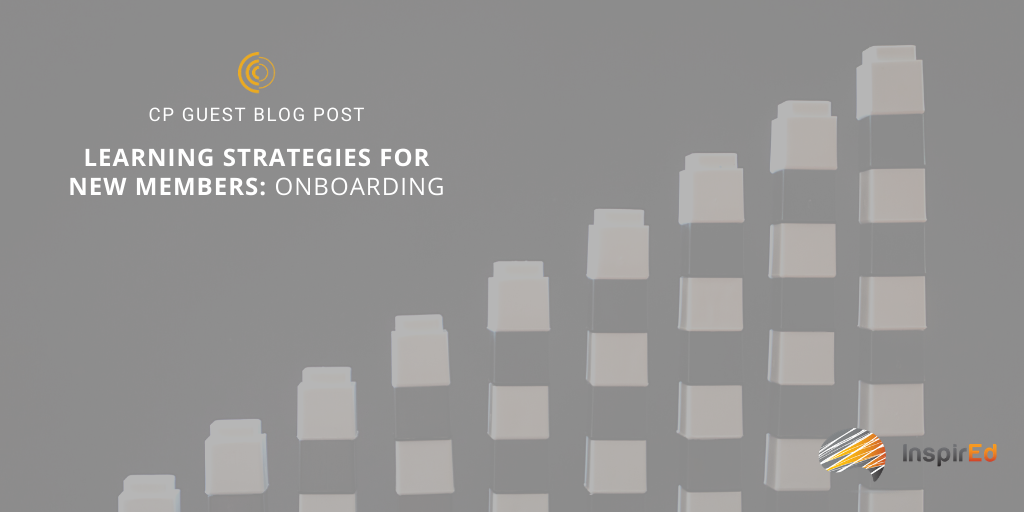
by Julie Ratcliffe | Sep 17, 2020 | Blog
This is a guest post written by Tracy King, CAE. As CEO of InspirEd, Tracy King leverages her more than 20 years in workforce development consulting with organizations on education strategy and learning design. Tracy is the author of Competitive Advantage: Create Continuing Education that is Profitable, Sustainable and Impactful, and she advises on how to grow reliably profitable and sustainable continuing education programs that transform learners. Tracy specializes in the intersection of learning science and technology. She’s a thought leader, invited speaker, master learning designer and DELP Scholar. Her work has been featured on NBC, ABC, FOX, USA Today, The Star Tribune and hundreds of nationally-syndicated television, newspaper, and magazine outlets. Tracy is a contributor to Microlearning in the Digital Age: The Design and Delivery of Learning in Snippets forthcoming by Routledge, Taylor & Francis group.
Meeting this moment has inspired so many organizations to embrace virtual and digital learning to connect with members and constituents in new ways. While the appetite for innovation is whet, consider these ideas for attracting and engaging new members.

While the membership packet of old has seen several upgrades, now is the perfect time to leverage your LMS for exciting opportunities to connect new members to all you offer. Online member onboarding is timely not only for our current virtually mediated moment but popular with younger professionals who want to explore – and revisit – resources at their point of need. Live webinars are not typically the best format when Zoomed-out professionals are looking for excuses to decline screen meetings.
Consider creating a choose-your-own-adventure style onboarding in your LMS aligning your organization’s services with new members’ greatest needs. Steer clear of bullet-list descriptions and lengthy presentations and instead opt for mobile-friendly storytelling. Collect brief member videos, each representing a constituency in your membership, as well as highlighting one key value proposition that tells the story of your association’s character and relevance. We really want our new members to see themselves in these stories, so they are inspired to engage. Next, present your benefits as answers to challenges, creating clear and clickable access to get started. Finally, showcase how new members can find a home within the network of professionals you represent. Consider how you can ensure a new member receives a personal, colleague-member outreach call or an invitation to a networking event, even if that’s a live chat in your LMS or texting with a Board Member within the first month of membership to welcome them to the community.
One more tip: Always recommend a next step. Each learning opportunity should end with a call to action to join you in another program.
Wins
-
Introduce your organization immediately upon member sign up – no waiting for the next webinar orientation presentation
-
Easily accessible point of need member resources giving new members a comfortable launch pad for exploring all you offer
-
A natural introduction to all the member-only goodies in your LMS
It doesn’t stop here. Tracy will be back next month with the next step in her learning strategies for new membership. Be sure to catch part two of this post next month, Learning Strategies for New Members: Microcredentialing.
If you’re interested in transforming your learning design, contact Tracy at info@inspired-ed.com. If you’re interested in Elevate LMS or in onboarding strategies for Elevate LMS, contact Meghan Gowen at mgowen@commpartners.com.
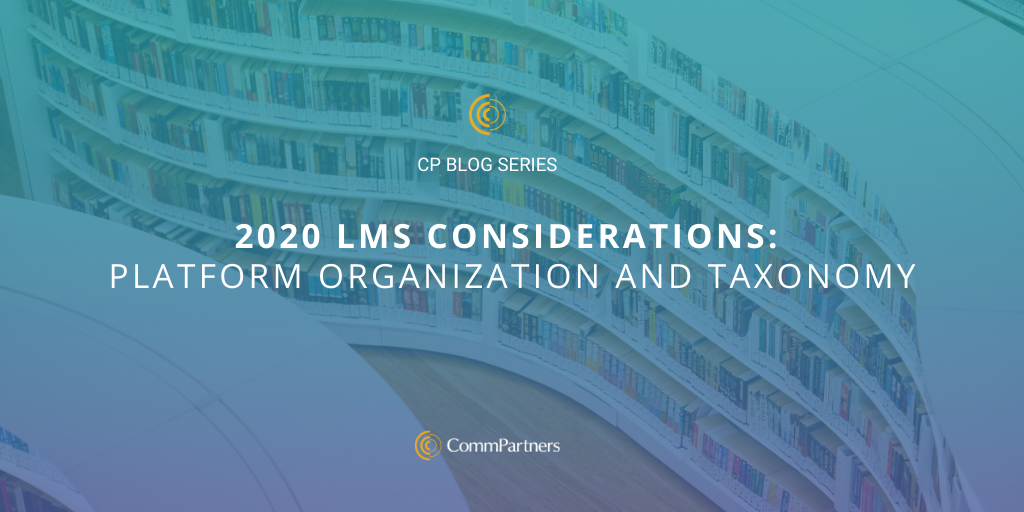
by Julie Ratcliffe | Sep 10, 2020 | Blog, Education
Imagine going to Amazon to purchase a new book and there is no search feature. You have to scroll through every single item Amazon sells until you come across the book you wanted. Phew, nightmare over. Not only does Amazon have a search bar, but it anticipates what you’re looking for, recommends what you might want next based on previous purchases, and items are organized into categories so you can easily search for what you’re looking for on your own.
Continuing our more in-depth look into CommPartners, CEO, Rich Feinstein’s The Evolution of the Association LMS: 10 Considerations for 2020, let’s talk about organizing content. Whether you’ve just implemented your LMS and you’re starting fresh with your organization system, or you’ve had it for years and you’re learning catalog could use a critical eye, a good taxonomy strategy is essential.
For many associations, their LMS is the primary source for education and connection since the pandemic started and their digital assets are growing. Creating a simple way to search and find content is essential for learners. There are several taxonomy and organization strategies to optimize searching and presentation of content:
“The more robust your taxonomy is, the better you’re empowering the LMS to meet your goals and changing goals,” Arianne Urena, Elevate Implementation and Project Manager. Arianne recommends establishing a taxonomy strategy as your first step when implementing your LMS. Consider these questions when developing your strategy:
- What content is offered on your site? Make a list of everything.
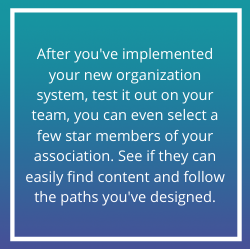
- What is the priority of each offering? Start with the essential items for your learners and then add in the supplemental pieces.
- Which assets are revenue generators? Mark those.
- Who is your audience? Are they familiar with an LMS? New members? Old members? How are they accessing the LMS? Member role? Job type? Apply the necessary categories.
- Use case: How will they navigate? How long does it take for them to find an asset? How do you correct any navigation delays?
- What is the ideal layout for your content on your LMS? What is the first thing a learner sees on the site? Second, third, fourth?
Once you’ve organized your content and you’ve established a robust taxonomy strategy, you can apply other organizational methods:
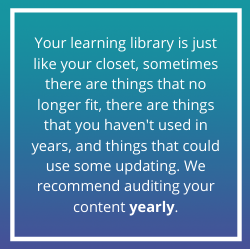
- One-click imagery or terms: Make finding content a snap by organizing it into categories and requiring only “one-click” to navigate.
- Keyword search: Include a keyword search bar on your LMS site so learners can search through your well organized content library.
- Personalized learning paths: To help your learners get started on their learning journey and navigate through all the content options, provide them with personalized learning pathways based on career paths, member roles, etc. with the individualized attention of an “advisor” from your staff. To learn how to create these paths, join us for our upcoming webinar Creating Personalized Learning Journeys.
- Self-Assessment Quiz: This is your chance to become the advisor. CommPartners’ Elevate has a new feature that allows administrators to gauge competency and make personalized content recommendations to learners based on their quiz results. Click here to find out more about the self-assessment quiz feature.
Creating a simple and easy-to-follow path to content within your LMS will eliminate frustration while encouraging your learners to register and keep coming back for more. To learn more about organization options for your LMS or Elevate, contact Meghan Gowen at mgowen@commpartners.com.


 Obtain and Maintain Certification
Obtain and Maintain Certification














